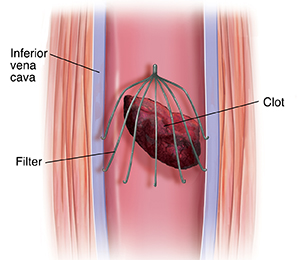Having Inferior Vena Cava (IVC) Filter Placement and Removal
An inferior vena cava (IVC) filter is a small device that can stop blood clots from going up into the lungs. The inferior vena cava is a large vein in the middle of your body. Blood returns to the lungs from the legs and lower body through the IVC. The device is put in during a short surgery. An IVC is considered for people at risk for deep vein blood clots in the lower body. These can break off and flow to the lungs causing a pulmonary embolism, which can be life-threatening.
The filter may be left in place permanently. Or it may be removed later once the risk of clots going up into the lungs has passed.

What to tell your healthcare provider
Tell your healthcare provider about all the medicines you take. This includes over-the-counter medicines, such as aspirin. Before the procedure, make sure to tell the medical team if you:
-
Have had any recent changes in your health, such as a fever
-
Take any medicines, including over-the-counter medicines, vitamins, minerals, or supplements
-
Are pregnant or could be
-
Have ever had a problem with anesthesia
-
Have any allergies
Tests before your procedure
You may need some tests before the procedure. These are to look at your health. Your healthcare provider can tell you more if you need tests.
Getting ready for your procedure
Talk with your healthcare provider about the type of IVC filter that you will have. Some filters can be taken out when your risk of DVT is lower. Others are meant to be permanent.
Talk with your healthcare provider about how to get ready for your procedure. You may need to stop taking some medicines ahead of time, such as blood thinners. If you smoke, you’ll need to stop before your procedure. Talk with your healthcare provider if you need help to stop smoking. Don't eat or drink after midnight the night before your procedure. Arrange to have someone available to drive you home after your procedure.
On the day of your procedure
Talk with your healthcare provider about what to expect during your procedure. You will be asked to sign an informed consent form before the procedure. Make certain all of your questions are answered before you sign it. The procedure usually takes about an hour. It's done by an interventional radiologist and a team of specialized nurses. A typical procedure may go like this:
-
An IV will be put in your arm or hand before the procedure starts. You’ll be given sedation through the IV line. This will make you relaxed and sleepy during procedure.
-
Hair in the area of your procedure may be removed. The area may be numbed with a local anesthesia.
-
Your healthcare provider will make a small incision in this region to access a major vein leading to the IVC.
-
A long thin tube (catheter) will be inserted into this vein.
-
Your healthcare provider will use continuous X-rays (fluoroscopy) and move the tube up into the IVC. Contrast material may be sent through the catheter to help show the IVC clearly on the X-rays.
-
Your healthcare provider will release the filter into the IVC. Here the filter will expand and attach itself to the walls of your IVC.
-
Your healthcare provider will remove the catheter.
-
Your healthcare provider will close the incision on your neck or groin and bandage it.
The procedure to remove an IVC filter is similar to the procedure for placement. A removable IVC filter has a small hook at the end that allows the catheter to attach to the filter, close it, pull it into the catheter, and remove it.
After your procedure
After the procedure, you will spend several hours in a recovery room. You may be sleepy and confused when you wake up. Your healthcare team will watch your vital signs, such as your heart rate and breathing. You’ll be given pain medicine if you need it. You may have a headache or nausea, but these should go away quickly.
You may be able to go home the same day. Your healthcare provider will tell you more about what to expect. When you are ready to go home, you will need to have a family member or friend drive you.
Recovering at home
Follow all of your healthcare provider’s instructions. This includes any advice about medicines, exercise, and wound care. You may have some pain after the procedure. You may notice a bruise where the catheter was inserted. You can take over-the-counter pain medicines if you need to. Get some rest and don't do any strenuous exercise for at least 24 hours.
Follow-up care
Make sure to keep all of your follow-up appointments. You will need continued watching after your treatment. You may need follow-up imaging tests to make sure your filter is still in the correct place. If you have the type of IVC filter that can be removed, it's important to have a plan to remove the filter as soon as it's no longer needed. In some cases, a removable filter is left in place. This may happen if scar tissue grows around the filter and it can't be removed.
When to call your healthcare provider
Call your healthcare provider right away if you have any of these:
-
Coldness or numbness in one of your limbs
-
Bleeding at the site that doesn’t stop with pressure
-
Swelling or pain at the incision site that gets worse
-
Fluid leaking from the incision site
-
Redness or warmth at the incision site
-
Fever
-
Shortness of breath or trouble breathing
-
Chest pain
-
Headache or nausea that doesn’t go away
-
Symptoms get worse or new symptoms develop